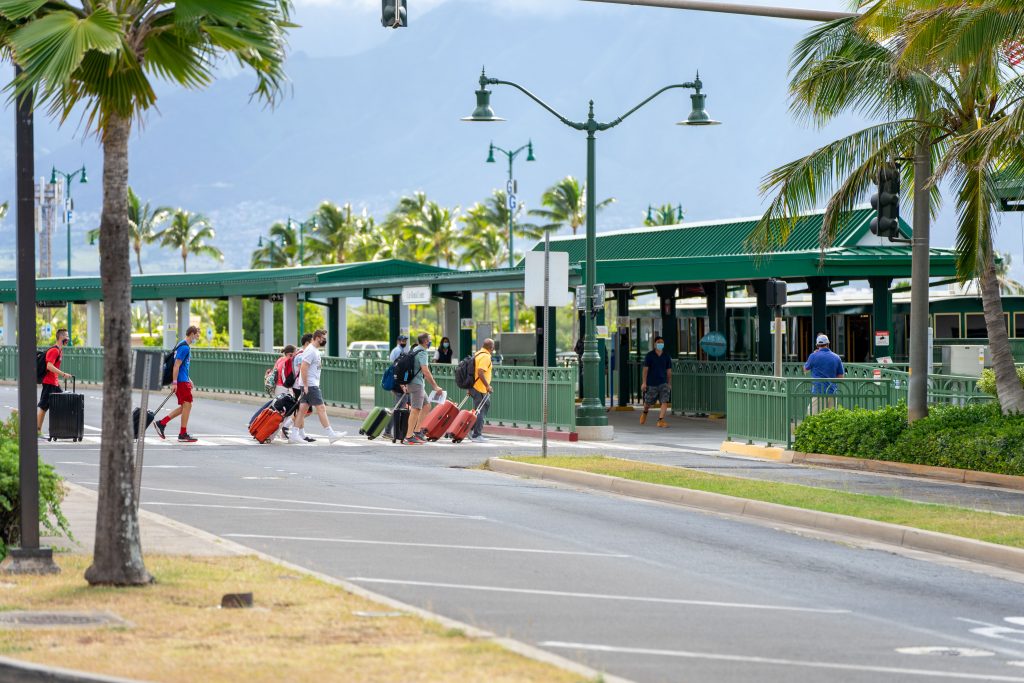Maui visitors in January more than double year over year, report says

Maui visitors in January more than doubled year over year, and U.S. Mainland travel to Hawaiʻi continues to rival or top pre-pandemic monthly numbers, according to recent reports released by the state.
There were 183,278 total visitor arrivals to Maui in January — a roughly 174% increase from the same timeframe in 2021 when 66,925 arrivals were recorded, according to the latest report from the state Department of Business, Economic Development and Tourism released Monday.
Largely driven by domestic travel since restrictions have impacted international trips, tourism is rebounding faster than originally expected, economists have said. Maui and other Neighbor Islands historically see strong domestic arrivals while Oʻahu receives the bulk of international travelers.
Overall in 2021, U.S. Mainland visitors accounted for about 95% of total visitors in Hawaiʻi, a separate DBEDT report said. Since May of last year, the state’s domestic visitor count has surpassed 2019 monthly levels.
January had 171,760 domestic arrivals to Maui. During the record-setting year of arrivals in 2019, January saw 181,567 domestic travelers to Maui.
Compared with pre-pandemic tourism in 2019 and early 2020, visitors from the U.S. Mainland are now spending more on a daily basis and staying longer, according to DBEDT.
For Maui, visitors in January spent $424.5 million, compared to $128.7 million in January 2021, $517 million in January 2020 and $474.2 million in January 2019.
For Oʻahu, visitor spending was $566.7 million, compared to $167.3 million in January 2021, $706.8 million in January 2020 and $700 million in January 2019.
Per person per day spending and per trip spending were highest in Maui County in January.
Visitors spent about $237 per day on Maui and $264 on Lānaʻi. Comparatively, people spent $233 per day on Oʻahu, $203 on Kauaʻi, $201 on Hawaiʻi island and $86 on Molokaʻi.
Per person per trip spending in January was about $2,316 for Maui, along with $2,128 for Hawaiʻi island, $2,044 for Oʻahu, $1,899 for Kauaʻi, $1,505 for Lānaʻi and $818 for Molokaʻi.
The average length of stay was longest on Hawaiʻi island in January at 10.6 days. Then it was Maui, 9.8 days; Molokaʻi, 9.47 days; Kauaʻi 9.34 days; Oʻahu 8.8 days and Lānaʻi, 5.7 days.
Statewide, a total of 574,183 visitors came in January. Of that, 567,179 visitors arrived by air, mainly from the U.S. West and U.S. East.
After a 21-month suspension, cruise operations resumed in January with the arrival of seven cruise ships that brought another 7,004 visitors to the state.
Cruise activity is an important part of the overall tourism in the state with cruise visitors accounting for 2.6% of Hawaiʻi’s total visitors in 2019, according to a statement by Mike McCartney, DBEDT director.
Even with omicron surging, the visitor arrivals level in January was more than 70% of the January 2019 level, he said, “indicating that the demand for Hawaiʻi visitation remains strong, especially from the U.S. Mainland.”
Looking ahead, global travel is reopening and Hawaiʻi is seeing pent-up demand, according to McCartney.
“We expect a strong summer and look forward to welcoming international visitors from Australia, New Zealand and Japan in the second half of the year,” he said in a news release.
After travel was largely shut down in 2020 due to the onset of the pandemic, Hawaiʻi reopened to tourism with the state’s Safe Travels program, which launched in October of that year and allowed trans-Pacific travelers to bypass quarantine by following testing or, later, vaccination requirements.
Maui saw a particularly strong resurgence in trans-Pacific arrivals the following months and year, fueled by pent-up demand and savings.
While Neighbor Island economies have a stronger reliance on tourism than Oʻahu, they also have fewer resources. As a result, Maui County Council has been mulling ways to mitigate the negative impacts of over-tourism.
Gov. David Ige announced recently that the Safe Travels program will end March 26.









